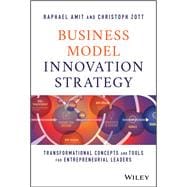The most comprehensive, global guide to business model design and innovation for academic and business audiences.
Business Model Innovation Strategy: Transformational Concepts and Tools for Entrepreneurial Leaders is centered on a timely, mission-critical strategic issue that both founders of new firms and senior managers of incumbent firms globally need to address as they reimagine their firms in the post COVID-19 world. The book, which draws on over 20 years of the authors collaborative theoretical and rigorous empirical research, has a pragmatic orientation and is filled with examples and illustrations from around the world.
This action-oriented book provides leaders with a rigorous and detailed guide to the design and implementation of innovative, and scalable business models for their companies. Faculty and students can use Business Model Innovation Strategy as a textbook in undergraduate, MBA, and EMBA degree courses as well as in executive courses of various designs and lengths. The content of the book has been tested in both degree and non-degree courses at some of the world's leading business schools and has helped students and firm leaders to develop ground-breaking business model innovations.
This book will help you:
- Learn the basics of business model innovation¯including the latest developments in the field
- Learn how business model innovation presents new and profitable business opportunities in industries that were considered all but immune to attacks from newcomers
- Learn how to determine the viability of your current business model
- Explore new possibilities for value creation by redesigning your firm's business model
- Receive practical, step-by-step guidance on how to introduce business model innovation in your own company
- Become well-versed in an important area of business strategy and entrepreneurship
Authors Amit and Zott anchored the book on their pioneering research and extensive scholarly and practitioner-oriented publications on the design, implementation, and performance implications of innovative business models. They are the most widely cited researchers in the field of business model innovation, and they teach at the top-ranked Wharton School of the University of Pennsylvania and the prestigious global business school IESE with campuses in Barcelona, Madrid, Munich, New York, and São Paulo.









